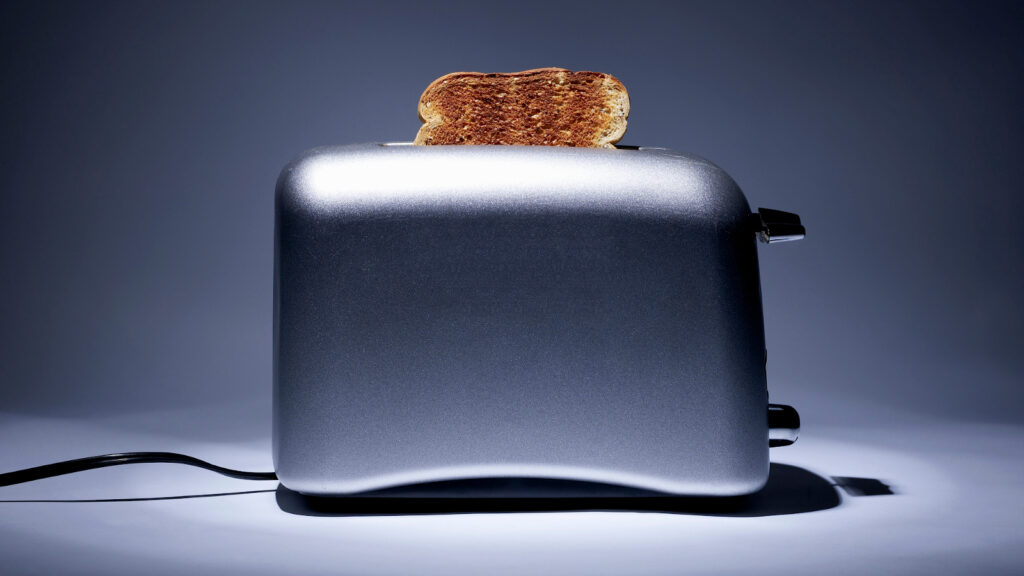Most toasters typically use 110-120 volts in regions that follow the North American electrical standard and 220-240 volts in regions that follow the European electrical standard.
The exact voltage may vary slightly depending on the specific toaster model and manufacturer, but these ranges are the most common.
What is Voltage?
Define voltage and its significance in electrical devices.
Voltage, often referred to as electric potential or electromotive force (EMF), makes electricity
flow. It represents the electrical potential difference between two points in an electrical circuit. In simple terms, the force pushes electric charge (usually electrons) through a conductor, such as wires, to create an electric current.
The significance of voltage in electrical devices lies in its role in providing the energy needed to power these devices.
When you plug in an electrical appliance, the voltage supplied by your electrical system allows the flow of electric current, which, in turn, powers the device.
Voltage is measured in volts (V), and different devices require specific voltage levels to function correctly and safely.
The standard voltage levels in household electrical systems (e.g., 110-120 in North America, 220-240 in Europe).

The standard voltage levels in household electrical systems vary worldwide, primarily due to historical and regional differences in electrical infrastructure. Here are two common voltage standards:
North America:
- In North America, including the United States and Canada, the standard voltage for household electrical systems is typically 110-120 volts. This lower voltage level results from the region’s historical electrical infrastructure development.
- The standard alternating current (AC) frequency in North America is 60 Hertz (Hz).
Europe and Many Other Parts of the World:
- In Europe and many other parts of the world, the standard voltage for household electrical systems is usually 220-240 volts. European countries adopted higher voltage levels to transmit electrical power over longer distances efficiently.
- The standard frequency of AC in Europe is 50 Hz.
It’s important to note that these voltage standards are not interchangeable. Plugging a device designed for 110-120 volts into a 220-240-volt outlet (or vice versa) can lead to serious damage to the device and pose safety hazards.
Voltage Requirements for Toasters
- Typical Voltage Range for Most Toasters:
Most toasters are designed to operate within a voltage range of 110-120 volts in regions that use the North American electrical standard, or 220-240 volts in regions that use the European electrical standard.
This voltage range covers the majority of toasters available on the market, and it is essential to ensure that the toaster you purchase is compatible with the voltage supplied in your region.
- Importance of Matching Voltage Requirements:
Matching the voltage requirement of your toaster with the electrical supply in your region is crucial for several reasons:
Safety: Operating a toaster at the wrong voltage can pose serious safety risks.
If you use a toaster designed for a lower voltage in an area with a higher voltage supply (overvoltage), it can lead to overheating, electrical shorts, and potentially cause a fire.
Conversely, using a toaster designed for a higher voltage in an area with lower voltage (Undervoltage) can result in the toaster not functioning properly and may also pose a fire hazard.
Performance: To ensure your toaster works efficiently and toasting times are consistent, it’s essential to match the voltage requirements.
Using a toaster with a mismatched voltage can result in uneven toasting, longer cooking times, or even undercooked or burnt toast.
Longevity: Operating a toaster at the correct voltage helps prolong its lifespan. Voltage fluctuations can stress the appliance unnecessarily and lead to premature wear and tear. Over time, this can lead to the need for repairs or replacement.
Warranty: Warranty coverage for appliances often depends on correct usage, including adhering to voltage requirements. Using a toaster outside its specified voltage range can void its warranty, leaving you responsible for repair or replacement costs.
Energy Efficiency: Toasters designed for specific voltage ranges are optimized to operate efficiently within those parameters. Mismatching voltages can result in higher energy consumption, increasing your utility bills.
Different Types of Toasters
Various Types of Toasters and Their Voltage Requirements:
Pop-Up Toasters:
- Pop-up toasters are the most common type of toasters designed for toasting slices of bread. They typically have two or four slots for bread slices.
Voltage Requirements: Pop-up toasters are commonly designed to operate within the voltage range of 110-120 volts in regions using the North American electrical standard and 220-240 volts in regions using the European electrical standard.
Toaster Ovens:
- Toaster ovens are versatile appliances that can perform various cooking functions, including toasting bread, baking, broiling, and more.
Voltage Requirements: Toaster ovens typically require a higher voltage than pop-up toasters. They often operate within the range of 110-120 volts in North America and 220-240 volts in Europe.
Conveyor Toasters:
- Conveyor toasters are often used in commercial settings, such as restaurants and cafes. They can handle a large volume of toast and continuously feed slices through a conveyor belt to achieve even toasting.
Voltage Requirements: Conveyor toasters usually have specific voltage requirements based on their design and capacity, which can vary. Depending on the model, they may require 110-120 volts or higher.
Toaster Grills:
Toaster grills, also known as sandwich makers or panini presses, are designed for toasting sandwiches, paninis, and similar items.
Voltage Requirements: Toaster grills typically operate within the 110-120 volts in North America and 220-240 volts in Europe.
Variations in Voltage Among Toaster Models:
Voltage requirements among toaster models can vary based on factors such as the toaster’s size, capacity, and intended use. Here are some common variations:
Commercial vs. Home Use: Commercial toasters, including conveyor toasters, may have higher voltage requirements due to their larger capacity and continuous use. Home-use toasters, on the other hand, typically have lower voltage requirements.
Toaster Oven Size: Larger toaster ovens designed for cooking or baking may have higher voltage requirements than smaller toaster ovens primarily used for toasting.
Specialty Toasters: Some specialty toasters, such as those designed for specific types of bread or bagels, may have unique voltage requirements to optimize their toasting performance.
Dual Voltage Toaster Ovens: Some toaster ovens are designed with dual voltage capabilities, allowing them to operate in both 110-120 volts and 220-240 volts regions, making them suitable for international use.
Power Settings: Toaster ovens may have multiple power settings, and the voltage requirement can vary depending on the selected setting. Higher power settings may require more voltage.
What Happens If the Voltage Doesn’t Match?
Potential Consequences of Using a Toaster with the Wrong Voltage:
Reduced Performance: If you use a toaster with a voltage higher than its design, it may operate at a higher wattage, resulting in uneven toasting or even burnt toast.
Conversely, using a toaster with a lower voltage than required may not get hot enough, leading to undercooked or barely toasted bread.
Safety Hazards: Voltage mismatches can pose serious safety risks. Here are some potential consequences:
Overheating: Using a toaster with a higher voltage than recommended can cause excessive heating, leading to melting components, electrical shorts, and potential fire hazards.
Fire Risk: Overheating due to voltage mismatches can ignite flammable materials around the toaster, such as paper towels or curtains, leading to a fire.
Electrical Damage: Mismatched voltage can damage the toaster’s internal electrical components, rendering it unusable and potentially causing electrical fires.
Electrical Shock: Faulty toasters operating at incorrect voltages can increase the risk of electrical shock if you come into contact with them while they are plugged in.
Appliance Damage: Using the wrong voltage can break your toaster for good. The internal wiring, heating elements, and other components may overheat or fail prematurely, requiring costly repairs or replacement.
Warranty Voidance: Most toaster manufacturers specify the correct voltage requirements for their products, and using the toaster outside these specifications can void any warranty coverage.
This means you may be responsible for repair or replacement costs.
Safety Concerns and Risks Associated with Voltage Mismatches:
Fire Hazard: Voltage mismatches can cause overheating and electrical shorts, increasing the risk of fires. Fires can spread rapidly, leading to property damage and potential harm to occupants.
Electrical Safety: Operating a toaster with the wrong voltage can pose a significant electrical hazard. It can increase the likelihood of electrical shock when touching the toaster or its components.
Property Damage: Fires caused by voltage mismatches in appliances like toasters can result in extensive property damage, including damage to your kitchen or home.
Personal Safety: Voltage mismatches can result in appliance malfunction, creating safety hazards in the kitchen. In extreme cases, they can lead to injuries or even fatalities.
Warranty Issues: Using a toaster with the wrong voltage can void its warranty, leaving you responsible for any repair or replacement costs.
How to Check Your Toaster’s Voltage?
How to Find the Voltage Rating on Your Toaster:
Check the Toaster’s Base or Bottom:
The easiest place to find voltage information on your toaster is usually on its base or bottom. Look for a label or sticker that provides electrical specifications, including voltage requirements.
Inspect the Toaster’s User Manual:
If you still have the toaster’s user manual, check it for voltage information. The manual often includes details about the appliance’s specifications and usage guidelines.
Examine the Toaster’s Plug or Cord:
Sometimes, voltage information is printed on the plug or the cord itself. Carefully inspect these areas for any labels or markings indicating voltage requirements.
Look for a Rating Plate:
Some toasters have a rating plate or tag that may be located on the back or underside of the toaster. This plate typically contains detailed information about the appliance, including voltage.
Tips for Finding Voltage Information if Not Visible:
If you cannot locate the voltage rating on your toaster through the methods mentioned above, consider the following tips:
Contact the Manufacturer: Reach out to the toaster’s manufacturer via their customer support or official website.
Provide them with the toaster’s model number and any other relevant details, and they should be able to provide you with the voltage requirements.
Inspect the Toaster’s Packaging: If you have the original packaging or box for your toaster, check if it contains voltage information. Manufacturers often include such details on the packaging.
Check Online Resources: Search for your toaster’s model online. Many product listings, retail websites, or forums may have information about the voltage requirements for common toaster models.
Ask a Qualified Electrician: If you’re still unable to determine the toaster’s voltage requirements, consider consulting a qualified electrician. They can assess the toaster and help you identify the correct voltage.
Use a Voltage Tester: If you’re comfortable working with electrical tools, you can use a voltage tester to measure the voltage required by your toaster.
This involves checking the voltage between the toaster’s plug prongs, but it should be done with caution and knowledge of electrical safety.
Remember that using a toaster with the wrong voltage can be dangerous, so it’s crucial to ensure that you have accurate voltage information before plugging it in.
Troubleshooting Voltage Issues of toaster

Solutions for Common Voltage-Related Problems with Toasters:
Voltage Too High (Overvoltage):
- If your toaster is designed for a lower voltage and you’re in an area with a higher voltage supply, you can use a voltage regulator or stabilizer. These devices can reduce the voltage to a safe level for your toaster.
- Alternatively, consider purchasing a new toaster that is compatible with your electrical supply.
Voltage Too Low (Undervoltage):
- If your toaster is designed for a higher voltage and you’re in an area with a lower voltage supply, you can use a voltage transformer or converter. These devices step up the voltage to match your toaster’s requirements.
- Again, an alternative is to purchase a new toaster that matches your electrical supply.
Fluctuating Voltage:
Voltage fluctuations can affect toaster performance. Installing a voltage stabilizer or surge protector can help regulate voltage and protect your toaster from voltage spikes and dips.
Safety Precautions:
To avoid voltage problems, make sure your outlets and wiring are in good shape. If you have issues, get a qualified electrician to check and fix them.
What to Do If Your Toaster Is Not Compatible with Your Electrical Supply:
Do Not Use the Toaster:
It is essential not to use a toaster incompatible with your electrical supply. Doing so can pose serious safety risks, including fire hazards and appliance damage.
Purchase a Compatible Toaster:
The safest and most practical solution is to purchase a new toaster that matches the voltage supplied in your region. Look for a toaster that is designed for the voltage standard used in your area (e.g., 110-120V in North America or 220-240V in Europe).
Consider a Dual Voltage Appliance:
If you frequently move between regions with different voltage standards, consider investing in a dual-voltage toaster or appliance. These appliances can operate in both 110-120V and 220-240V regions, offering versatility.
Return or Exchange:
If you recently purchased a toaster that is not compatible with your electrical supply, check the retailer’s return or exchange policy. You may be able to return the toaster and select a suitable replacement.
FAQs
How many volts does a toaster use?
Most toasters are designed to operate on the standard household voltage, which is approximately 120 volts in North America and 230-240 volts in many other regions.
Is the voltage for toasters the same worldwide?
No, the voltage for toasters can vary depending on the country or region’s electrical standards. It is important to check the voltage rating on your toaster and use it with the appropriate voltage supply.
Can I use a toaster designed for one voltage in a region with a different voltage?
No, you should not use a toaster designed for one voltage in an area with a different voltage without a voltage converter or transformer. Doing so can damage the toaster and pose safety risks.
Do toasters have voltage converters built in?
No, toasters do not have built-in voltage converters. They are designed to work with the standard voltage of the region where they are sold.
What should I do if I move to a different country with a different voltage?
If you move to a country with a different voltage, you may need to purchase a new toaster designed for the local voltage or use a voltage converter or transformer to adapt your existing toaster.
Can using the wrong voltage damage my toaster?
Yes, using the wrong voltage can potentially damage your toaster, causing it to malfunction or even become a safety hazard. It’s essential to use the correct voltage.
How can I determine the voltage requirements of my toaster?
You can usually find the voltage requirements of your toaster on a label or plate located on the appliance. It should specify the voltage range it can safely operate with.
Is it safe to use a voltage converter with a toaster?
Yes, it’s safe to use a voltage converter or transformer to adapt your toaster to a different voltage, as long as you choose an appropriate converter that can handle the toaster’s power requirements.
Can a toaster run on a lower voltage if I have no other option?
Operating a toaster on lower voltage than it’s designed for can result in uneven toasting or slower performance. It’s best to use the correct voltage whenever possible.
What happens if there’s a voltage surge or power outage while using a toaster?
Voltage surges and power outages can affect electrical appliances, including toasters. Using surge protectors can help safeguard your appliances from voltage spikes.
Is there a way to convert the voltage of my entire kitchen for an appliance like a toaster?
Converting the voltage of your entire kitchen is a complex and costly undertaking. It’s more practical to use voltage converters for appliances requiring a different voltage.
Conclusion
In conclusion, most toasters typically operate on either 110-120 volts (North American standard) or 220-240 volts (European standard).
Understanding and ensuring that your toaster’s voltage matches the electrical supply in your region is essential for safe and efficient operation.
Using the correct voltage helps prevent safety hazards, ensures proper toasting performance, and prolongs the appliance’s lifespan.
Always prioritize safety and adhere to the manufacturer’s specifications to enjoy hassle-free toasting with your appliance.

